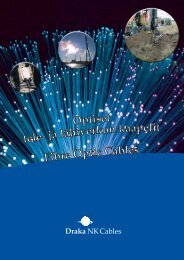Cables for Installations and Industry - Draka
Cables for Installations and Industry - Draka
Cables for Installations and Industry - Draka
You also want an ePaper? Increase the reach of your titles
YUMPU automatically turns print PDFs into web optimized ePapers that Google loves.
DATA CA BLES<br />
64<br />
GEN ERAL<br />
GE NE RIC CAB LING SYS TEMS<br />
Generic cabling is applied to telecommunication cabling<br />
as a permanent part of the office to meet the exp<strong>and</strong>ing<br />
needs of the user’s. It meets also the future data<br />
transmission requirements including new computers <strong>and</strong><br />
relocation of the workstations on the premises<br />
- minimizing the need <strong>for</strong> new cabling.<br />
The physical structure of a generic cabling system is<br />
star-shaped. This makes the network control easier which<br />
is important especially now when the telecommunication<br />
<strong>and</strong> data networks in buildings are the property of<br />
the owner. A star-shape cable system allows to change<br />
the network topology from the cross-connection to a bus<br />
or a ring. In a star-shape system all the active components<br />
can be placed together in one space which is easy to<br />
control <strong>and</strong> can be locked <strong>and</strong> which improves data<br />
security. Also measurements <strong>and</strong> maintenance are easier<br />
to carry out in the cross-connection area. lf one branch of<br />
the star network falls off the whole system is not paralyzed<br />
because the faulty branch can be disconnected from the<br />
network.<br />
The generic cabling system is not really open until its<br />
components are vendorindependent. They just have to<br />
con<strong>for</strong>m to the st<strong>and</strong>ards. When planning a cable system<br />
it is important to consider what the openness really means<br />
<strong>and</strong> how open the non-compatible <strong>and</strong> vendor-dependent<br />
cable systems are.<br />
STAN DARDS<br />
The European st<strong>and</strong>ard <strong>for</strong> the generic cabling systems<br />
is EN 50173 which was set up on the basis of the<br />
international ISO/IEC 11801. The corresponding st<strong>and</strong>ard<br />
in the U.S. is ANSI/TIA/EIA 568-A supported by TIA <strong>and</strong><br />
EIA. The EN 50173 applicable in Europe defines the<br />
different transmission line applications <strong>and</strong> classes as well<br />
as the categories 3 <strong>and</strong> 5 <strong>for</strong> the line components.<br />
For example, a data network that fulfills the requirements<br />
of class D can be set up from components of category 5.<br />
EN 50173 recommends the use of 100 Ω twisted-pair<br />
cables in horizontal cabling.<br />
Cat. 6 st<strong>and</strong>ard will be ready in 2001.<br />
SCREENING<br />
The abbreviations UTP, FTP <strong>and</strong> STP-screening<br />
construction are used to refer to the cable. UTP is a cable<br />
where symmetrical twisted pairs are used <strong>for</strong> screening.<br />
A FTP cable has an overall metal shield, <strong>and</strong> in a STP<br />
cable all the pairs are screened separately. The cable type<br />
is chosen to suit the environment where it’s used.<br />
In Finl<strong>and</strong> most of the installations are made with FTP <strong>and</strong><br />
UTP cables. Optical fibre cables are recommended <strong>for</strong><br />
local <strong>and</strong> rising cabling.<br />
The STP may also be marked ScTP <strong>and</strong> S/STP, meaning<br />
a construction with a pair <strong>and</strong> an overall shield.<br />
AP PLI CA TION AND TRANS MIS SION<br />
CLASSES<br />
Transmission<br />
classes<br />
A<br />
B<br />
C<br />
D<br />
Application Maximum<br />
frequency<br />
Voice b<strong>and</strong> <strong>and</strong><br />
low-frequency<br />
applications<br />
100 kHz<br />
Medium-speed<br />
data applications 1 MHz<br />
Fast data<br />
applications 16 MHz<br />
Very fast data<br />
applications 100 MHz<br />
E Very fast data<br />
applications 200 MHz<br />
OPTICAL<br />
Very fast data<br />
applications<br />
A ge neric ca bling sys tem con structed <strong>for</strong> a cer tain<br />
ap pli ca tion con sists of one or sev eral trans mis sion lines.<br />
REC OM MEN DA TIONS<br />
— It is important to examine the building needs very<br />
carefully, including e.g. the existing network <strong>and</strong><br />
the desires <strong>for</strong> more extended data transmission<br />
in the future.<br />
— The maximum length of horizontal cabling is 90 m.<br />
The maximum length of cross-connection <strong>and</strong><br />
equipment cabling is 10 m.<br />
— An optical fibre cable is recommended <strong>for</strong> local <strong>and</strong><br />
rising cabling.<br />
— Two double cables should be installed <strong>for</strong> each work<br />
area, in order to meet the increasing need of<br />
telecommunication.<br />
DATA TRANSMISSION CABLES<br />
Our complete range of UC cables fulfills tomorrow’s<br />
needs. Our new product family UC 400 is designed <strong>for</strong><br />
applications beyond CAT 5 with good properties.<br />
Our new development <strong>for</strong> the high-end field is UC 1000.<br />
A cable class that not only fulfills the above mentioned<br />
st<strong>and</strong>ards, but also offers reserves, allowing base b<strong>and</strong><br />
transmission of Gigabit-Ethernet.<br />
_





